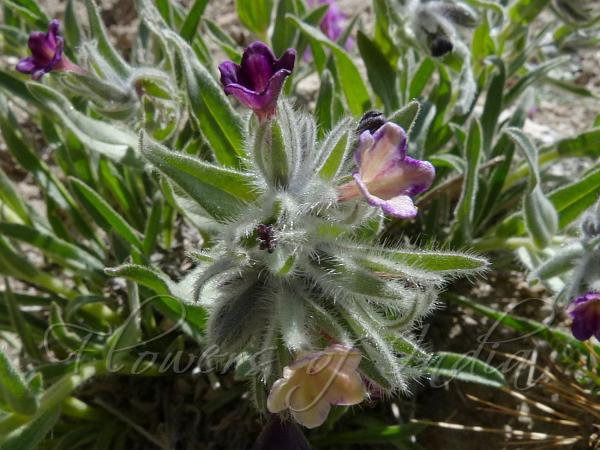|
| Pink Arnebia |
|

|

| File size | 257054 |
| Original date | 7/2/12 1:41 PM |
| Resolution | 1300 x 975 |
| Flash | Flash did not fire, auto |
| Focal length | 4.5mm |
| Exposure time | 1/400s |
| Aperture | 5.6 |
| Focus Distance | |
| Metering Mode | Multi-segment |
| Camera make | Panasonic |
| Camera model | DMC-FZ40 |
| Sensor type | OneChipColorArea |
|
|
|
|
Photo: |
Botanical name: Arnebia euchroma Family: Boraginaceae (Forget-me-not family)
Synonyms: Arnebia perennis, Arnebia endochroma, Macrotomia euchroma
Synonyms: Arnebia perennis, Arnebia endochroma, Macrotomia euchroma
Pink Arnebia is an erect hairy perennial. Roots are
thick, exuding a purplish dye. Stems are several, up to 40 cm tall,
axillary, arising amidst the leaves of previous year, fistular,
channelled, hairy. Hairs are up to 2 mm long. Basal leaves are 3.5-12.5
cm x 5-11 mm, upper ones shorter, lanceshaped, strigosely hairy, the
hairs with bulbous base. Flowers are borne in round clusters, 4-5 cm
across, Bracts are leafy, size of sepals. Flowers are purple to
pale-yellow tinged with purple in colour, almost stalkless. Sepal tube
is 1.3-1.7 cm long, hairy with yellowish-white to white hairs up to 2
mm long. Sepals are linear-lanceshaped. Flower tube is 0.9-1.7 mm long,
limb 1-1.5 cm broad, petals circular. Anthers are linear, 2.4-3 mm
long, attached near throat of corolla tube or at the middle. Nutlets
are 3.5 mm long, rugose-tuberculate, greyish in colour, keeled. Pink
Arnebia is found in W. & C. Asia, Himalayas, from Kashmir to Nepal and
Tibet, at altitudes of 3500-4000 m. Flowering: June-July.
Medicinal uses:  The root is antipyretic, cancer, contraceptive, emollient and
vulnerary. It is used in the treatment of measles, mild constipation,
burns, frostbite, eczema, dermatitis etc. Experimentally it has shown
contraceptive action on rats, inhibiting oestrus, the fertility rate
and the release of pituitary gonadotrophin hormone and chorion
gonadotrophin hormone. It inhibits the growth of cancer cells on the
chorion membrane.
The root is antipyretic, cancer, contraceptive, emollient and
vulnerary. It is used in the treatment of measles, mild constipation,
burns, frostbite, eczema, dermatitis etc. Experimentally it has shown
contraceptive action on rats, inhibiting oestrus, the fertility rate
and the release of pituitary gonadotrophin hormone and chorion
gonadotrophin hormone. It inhibits the growth of cancer cells on the
chorion membrane.
 The root is antipyretic, cancer, contraceptive, emollient and
vulnerary. It is used in the treatment of measles, mild constipation,
burns, frostbite, eczema, dermatitis etc. Experimentally it has shown
contraceptive action on rats, inhibiting oestrus, the fertility rate
and the release of pituitary gonadotrophin hormone and chorion
gonadotrophin hormone. It inhibits the growth of cancer cells on the
chorion membrane.
The root is antipyretic, cancer, contraceptive, emollient and
vulnerary. It is used in the treatment of measles, mild constipation,
burns, frostbite, eczema, dermatitis etc. Experimentally it has shown
contraceptive action on rats, inhibiting oestrus, the fertility rate
and the release of pituitary gonadotrophin hormone and chorion
gonadotrophin hormone. It inhibits the growth of cancer cells on the
chorion membrane. | Identification credit: Tabish | Photographed in Ladakh. |